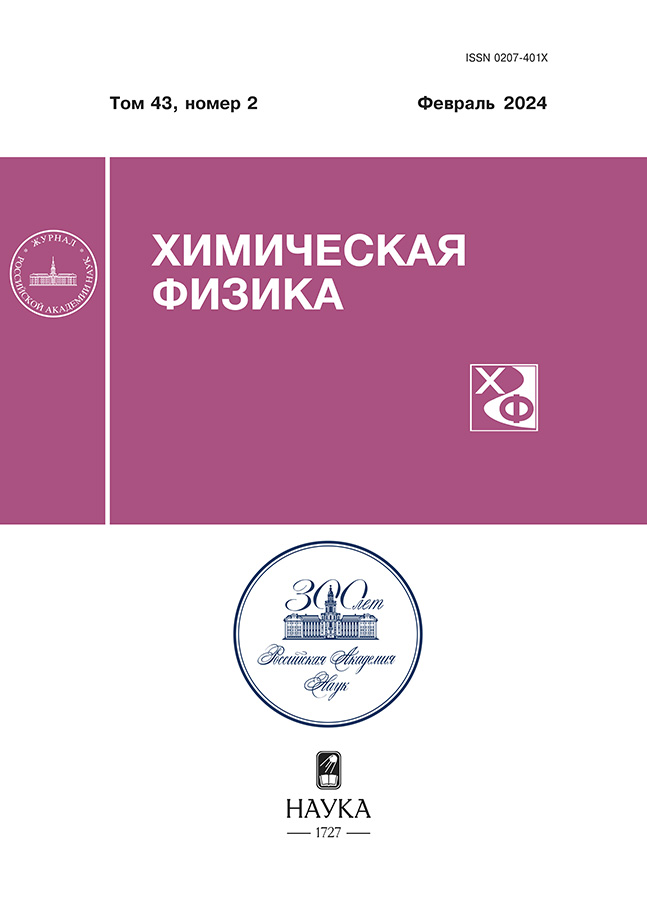Photochemistry of IrCl63– complex in aqueous solutions
- 作者: Zhdankin G.I.1,2, Grivin V.P.1, Plyusnin V.F.1,2, Tsentalovich Y.P.3, Glebov E.M.1
-
隶属关系:
- Voevodsky Institute of Chemical Kinetics and Combustion, Siberian Branch of the Russian Academy of Sciences
- Novosibirsk State University
- International Tomography Center, Siberian Branch of the Russian Academy of Sciences
- 期: 卷 43, 编号 2 (2024)
- 页面: 45-55
- 栏目: ФИЗИЧЕСКИЕ МЕТОДЫ ИССЛЕДОВАНИЯ ХИМИЧЕСКИХ РЕАКЦИЙ
- URL: https://cardiosomatics.orscience.ru/0207-401X/article/view/674985
- DOI: https://doi.org/10.31857/S0207401X24020053
- EDN: https://elibrary.ru/WHZGPH
- ID: 674985
如何引用文章
详细
The photochemistry of the [IrIIICl6]3- complex in aqueous solutions was studied by the methods of stationary and laser flash photolysis. As the result of a light quantum absorption, parallel processes of photoaquatation and photoionization occur. The aquated electron ea–q, which is formed with a quantum yield of 0.12 (excitation at 266 nm), is predominantly decayed in reactions with the initial complex and dissolved oxygen. The rate constant of ea–q capture by the [IrIIICl6]3- complex was measured. The main final photolysis products are Ir(III) complexes with different compositions of ligands, as well as several percents of Ir(IV) complexes. The formation of final products occurs in the time range from milliseconds to seconds.
全文:
作者简介
G. Zhdankin
Voevodsky Institute of Chemical Kinetics and Combustion, Siberian Branch of the Russian Academy of Sciences; Novosibirsk State University
Email: glebov@kinetics.nsc.ru
俄罗斯联邦, Novosibirsk; Novosibirsk
V. Grivin
Voevodsky Institute of Chemical Kinetics and Combustion, Siberian Branch of the Russian Academy of Sciences
Email: glebov@kinetics.nsc.ru
俄罗斯联邦, Novosibirsk
V. Plyusnin
Voevodsky Institute of Chemical Kinetics and Combustion, Siberian Branch of the Russian Academy of Sciences; Novosibirsk State University
Email: glebov@kinetics.nsc.ru
俄罗斯联邦, Novosibirsk; Novosibirsk
Yu. Tsentalovich
International Tomography Center, Siberian Branch of the Russian Academy of Sciences
Email: glebov@kinetics.nsc.ru
俄罗斯联邦, Novosibirsk
E. Glebov
Voevodsky Institute of Chemical Kinetics and Combustion, Siberian Branch of the Russian Academy of Sciences
编辑信件的主要联系方式.
Email: glebov@kinetics.nsc.ru
俄罗斯联邦, Novosibirsk
参考
- Zhang X., Wu F., Deng N. et al. // React. Kinet. Catal. Lett. 2008. V. 94. № 2. P. 207.
- Tyutereva Yu.E., Grivin V.P., Xu J et al. // Environ. Sci. Poll. Res. 2021. V. 47. P. 67891.
- Wu F., Deng N., Glebov E.M. et al. // Russ. Chem. Bull., Int. Edit. 2007. V. 56. № 5. P. 900 (Engl. Transl.).
- Zhang X., Gong Y., Wu F. et al. Russ. Chem. Bull., Int. Edit. 2009. V. 58. № 9. P. 1828 (Engl. Transl.).
- Bednarski P.J., Mackay F.S., Sadler P.J. // Anti-Cancer Agents Med. Chem. 2007. V. 7. № 1. P. 75.
- Gurruchaga-Pereda J., Martínez A., Terenzi A., Salassa L. // Inorg. Chim. Acta. 2019. V. 495. Article 118981.
- Alfassi Z.B., Shuler R.H. // J. Phys. Chem. 1985. V. 89. № 15. P. 3359.
- Neta P., Huie R.E., Ross A.B. // J. Phys. Chem. Ref. Data. 1988. V. 17. № 3. P. 1027.
- Shushakov A.A., Pozdnyakov I.P., Grivin V.P. et al. Dalton Trans. 2017. V. 46. № 29. P. 9440.
- Zhdankin G.I., Grivin V.P., Plyusnin V.F. et al. // Mendeleev Commun. 2022. Accepted.
- Butler J.S., Woods J.A., Farrer N.J. et al. // J. Am. Chem. Soc. 2012. V. 134. № 40. P. 16508.
- Ram M.S., Stanbury D.M. // J. Phys. Chem. 1986. V. 90. № 16. P. 3691.
- DeFelippis M.R., Murthy C.P., Faraggi M., Klapper M.H. // Biochemistry. 1989. V. 28. № 11. P. 4847.
- Jorgensen C.K. // Mol. Phys. 1959. V. 2. № 3. P. 309.
- Glebov E.M., Pozdnyakov I.P., Plyusnin V.F., Khmelinskii I. // J. Photochem. Photobiol. C: Photochem. Rev. 2015. V. 24. P. 1.
- Glebov E.M. // Russ. Chem. Bull. Int. Edit. 2022. V. 71. № 5. P. 858 (Engl. Transl.).
- Eidem P.K., Maverick A.W., Gray, H.B. // Inorg. Chim. Acta. 1981. V. 50. № 1. P. 59.
- Waltz W.L., Adamson A.W. // J. Phys. Chem. 1969. V. 73. № 12. P. 4250.
- Pozdnyakov I.P., Plyusnin V.F., Grivin V.P. et al. // J. Photochem. Photobiol. A: Chem. 2006. V. 182. № 1. P. 75.
- Tsentalovich Y.P., Sherin P.S., Kopylova L.V. et al. // IOVS (Investig. Ophthalmol. Vis. Sci.). 2011. V. 52. № 10. P. 7687.
- Savina E.D., Tsentalovich Yu.P., Sherin P.S. // Free Rad. Biol. Med. 2020. V. 152. P. 482.
- Poulsen I.A., Garner C.S. // J. Am. Chem. Soc. 1962. V. 84. № 10. P. 2032.
- Hare P.M., Price E.A., Bartels D.M. // J. Phys. Chem. A. 2008. V. 112. № 30. P. 6800.
- Glebov E.M., Plyusnin V.F., Tkachenko N.V., Lemmetyinen H. // Chem. Phys. 2000. V. 257. № 1. P. 79.
- Buxton G.V., Greenstock C.L., Philip Helman W., Ross A.B. // J. Phys. Chem. Ref. Data. 1988. V. 17. № 2. P. 513.
- Anbar M., Hart E.J. // Adv. Chem. Ser. 1968. V. 81. P. 79.
- Broszkiewicz R.K. // J. Chem. Soc. Dalton Trans. 1973. № 17. P. 1799.
- Crawford Ch.L., Gholami M.R., Roberts S.L., Hanrahan R.J. // Radiat. Phys. Chem. 1992. V. 40. № 3. P. 205.
- Treinin A., Hayon E. // J. Am. Chem. Soc. 1975. V. 97. № 7. P. 1716.
- Kovalenko N.L., Rogin N.D., Malchikov G.D. // Zhurn. Neorg. Khim. (Russian Journal of Inorganic Chemistry) // 1982. V. 27. № 4. P. 986 (in Russian).
- El-Awady A.A., Bounsall E.J., Garner, C.S. // Inorg. Chem. 1967. V. 6. № 1. P. 79.
- Pelizetti E., Mentasti E., Pramauro E. // J. Chem. Soc. Perkin Trans. 1978. V. 2. № 7. P. 620.
- Bus’ko E.A., Burkov K.A., Kalinin S.K. // Zhurn. Anal. Khim. (Russian Journal of Analytical Chemistry. 1974. V. 29. № 2. P. 340 (in Russian).
- Glebov E.M., Pozdnyakov I.P., Grivin V.P. et al. // Photochem. Photobiol. Sci. 2011. V. 10. № 3. P. 425.
- Pankratov D.A., Komozin P.N., Kiselev Yu.M. // Russ. J. Inorg. Chem. 2011. V. 56. № 11. P. 1794 (Engl. Transl.).
补充文件

注意
Х Международная конференция им. В.В. Воеводского “Физика и химия элементарных химических процессов” (сентябрь 2022, Новосибирск, Россия).














